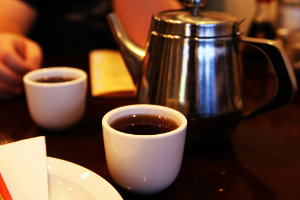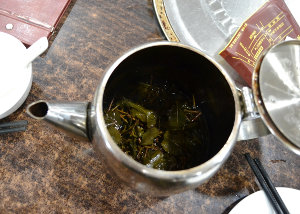Chinese Restaurant Teas
Last Updated: Dec. 8, 2014
 Tea in Chinese restaurants is often served in metal teapots and small teacups. Photo by Quinn Dombrowski, licensed under CC BY-SA 2.0.
Tea in Chinese restaurants is often served in metal teapots and small teacups. Photo by Quinn Dombrowski, licensed under CC BY-SA 2.0.Although the types of tea served in these restaurants vary, there are certain trends and patterns.
Most common teas served in Chinese restaurants
Oolong tea is one of the most common teas served in Chinese restaurants. Typically the oolongs are darker oolong teas with a good amount of roast; greener oolongs are rarely served in these restaurants. These teas tend to have a brown color, slightly lighter than most black tea, and a woody, moderately roasted aroma; they tend to be somewhat like black tea but less bitter. In the U.S., Chinese restaurants infrequently use whole-leaf tea. This photo was taken in Zhuhai, Guangdong, China. Photo by David Boté Estrada, licensed under CC BY-SA 2.0.
In the U.S., Chinese restaurants infrequently use whole-leaf tea. This photo was taken in Zhuhai, Guangdong, China. Photo by David Boté Estrada, licensed under CC BY-SA 2.0.Jasmine tea, a jasmine-scented tea, usually with a green base tea, is most common in Vietnamese restaurants, and is sometimes also served in Chinese restaurants. Jasmine tea is distinctive, and is often described as floral or perfumey. Unflavored Chinese green teas are also sometimes served. Some of these teas, such as gunpowder green tea or chun mee, have a smoky quality. Japanese restaurants, by contrast, tend to serve Japanese green teas such as sencha or genmaicha, which are generally not served in Chinese restaurants.
Korean restaurants frequently serve barley tea, and less frequently serve an herbal tea made from roasted corn, or Japanese green teas.
One brand of tea, Dynasty, actually markets a tea blend called Chinese Restaurant Tea, which is a blend of oolong tea, jasmine-scented green tea, and unscented green tea. This blend occupies a middle ground between the different teas most commonly served in Chinese restaurants.
Buying your own "Chinese restaurant tea"
Our recommendation, if you wish to locate teas that taste the most like teas served in Chinese restaurants, is to first figure out whether the teas you like are darker oolongs, Pu-erh, jasmine tea, or some other type of tea. Then, explore our site to locate brands selling high-quality loose-leaf tea in these styles.Does the tea you are looking for have a light color and a distinctive, perfumey, floral scent? If the tea is light in color but lacks a clear jasmine scent, it is probably green tea. If so, it is probably jasmine tea. If it is darker in color, but lighter than black tea, it is probably oolong. Among oolongs, look at relatively darker, moderately roasted teas. If the tea you are looking for is very dark in color, opaque and darker than black tea, with a dusty or earthy aroma, it is probably cooked or ripened Pu-erh. If you are in a Japanese restaurant, it is probably Japanese green tea like genmaicha, sencha, or hojicha. At a Korean restaurant, it is probably barley tea, or a Japanese green tea.
If you're looking to get more into tea, you can use this new knowledge as a starting point. Most restaurants specialize in food, not tea, and it is likely that if you sample teas on your own, you will soon discover teas that you enjoy far more than the tea served in any restaurant.

